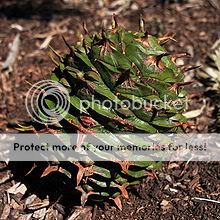Araucaria bidwillii, (A.bidwillii ) the Bunya Pine, is NOT a pine at all but is
a large evergreen coniferous tree in the genus Araucaria, family Araucariaceae. It is native to
south-east Queensland with two small disjunct populations in
northern Queensland's World Heritage listed Wet Tropics, and many fine old
specimens planted in New South Wales (we have several 30 metre+ specimens around
the township of Yass, where I live), and around the Perth, Western Australia, metropolitan
area. It can grow up to 30–45 metres.
The
Bunya Pine is the last surviving species of the Section Bunya of the genus Araucaria.
This section was diverse and widespread during the Mesozoic with some species having cone
morphology similar to the A. bidwillii, which appeared during the Jurassic Period, i.e. 199.6 to 145.5 million years ago* — a
54-million-year chunk of the Mesozoic Era - and lends authority to the speculative assumption that dinosaurs and other large reptiles such as the pterodactyl helped in widespread scattering of tree seeds accounting for archaeological evidence of their previous extant.
Note the residential home under and behind the tree in this image.
A.bidwillii has a
limited distribution within Australia in part because of the drying out of
Australia with loss of rainforest and poor seed dispersal but mainly due to eradication of forest stands by man as part of land-clearing. The remnant sites at
the Bunya Mountains, Jimna area, and Mount Lewis in Queensland have genetic diversity.
A mature Bunya Pine cone on the ground
The cones are large, soft-shelled and nutritious and fall
intact to the ground beneath the tree before dehiscing. The cones may grow 20–35 cm in diameter, and are opened by large birds, such as cockatoos, or disintegrate when mature to release the large (3 - 4 cm) seeds or nuts.
This is probably one of the most common reasons given for request to remove mature Bunya Pines from residential areas as the cones can be very
large, heavy and fall over 30 metres+.
At the time of white settlement, A.bidwillii occurred in
great abundance in southern Queensland, to the extent that a Bunya Bunya
Reserve was declared in 1840 to protect its habitat. The tree once grew as
large groves or sprinkled regularly as an emergent species throughout other
forest types on the Upper Stanley and Brisbane
Rivers, Sunshine Coast hinterland (especially the Blackall Range near Montville and Maleny), and also towards and on the Bunya Mountains. Today, the species is usually encountered as very small
groves or single trees in its former range, except on and near the Bunya
Mountains, where it is still fairly prolific.
A.bidwillii was a sacred
tree for the Aboriginal people. The vernacular name is bunya, bonye, bunyi or bunya-bunya, from various tribes or European variations of
the Australian Aboriginal name for the tree. It is also commonly referred to as the "false
monkey puzzle", despite its obvious physical differences from the monkey
puzzle tree (Araucaria araucana).
The seeds are edible, and are similar to pine nuts, and have been an important food resource for Australian
Aboriginal people. Groves of the trees were often under particular tribal/
family ownership. In what was probably Australia's largest indigenous event,
diverse tribes - up to thousands of people - once travelled great distances
(from as far as Charleville, Dubbo, Bundaberg and Grafton) to the Bunya
Mountains and Blackall Ranges of Queensland. They stayed for months, to
celebrate and feast on the bunya nut. The bunya gatherings were an armistice
accompanied by much trade exchange, and discussions/ negotiations over marriage
and regional issues.
The
nutritional content of the bunya nut is:
- 40% water,
- 40% complex carbohydrates,
- 9% protein,
- 2% fat,
- 0.2% potassium,
- 0.06% magnesium.
It is also gluten
free, making bunya nut flour a substitute for people with gluten intolerance.
Due to the sacred status of the bunyas, some tribes would
not camp amongst these trees. In some regions, the tree was never to be
cut.
Bunya nuts are slow to germinate. A set of 12 seeds sown in Melbourne took an average of about six months to germinate (with the
first germinating in 3 months) and only developed roots after 1 year.
A test of germination was carried out, starting in 1999. Seeds were extracted from two mature cones collected from
the same tree, a cultivated specimen at Petrie, just north of Brisbane. One
hundred apparently full seeds were selected and planted into 30cm by 12cm
plastic tubes commercially filled with sterile potting mix in early February
1999. These were then placed in a shaded area and watered weekly. Four tubes
were lost due to being knocked over.
A total of the 100 seeds placed 87 germinated.
The tubes were checked monthly for emergence over 3 years.
Of these seeds,
- 55 cones emerged from each month from April to December, 1999;
- 32 emerged from January- September in 2001;
- 1 seed emerged in January 2001, and,
- the last 1 appeared in February 2001
Once established bunyas are quite hardy and can be grown as
far south as Hobart in Australia (42° S) and Christchurch in New
Zealand (43° S) and
(at least) as far north as Sacramento in California (38° N) and Lisbon (in the botanical garden). One has even been grown in Dublin in Ireland (53ºN) in a micro climate protected from arctic winds and
moderated by the Gulf Stream.
They will reach a height of 35 to 40 metres
The Bunya Pine will live for about 500 years.




1 comment:
I would not want that to hit me on the head. ;-)
Post a Comment